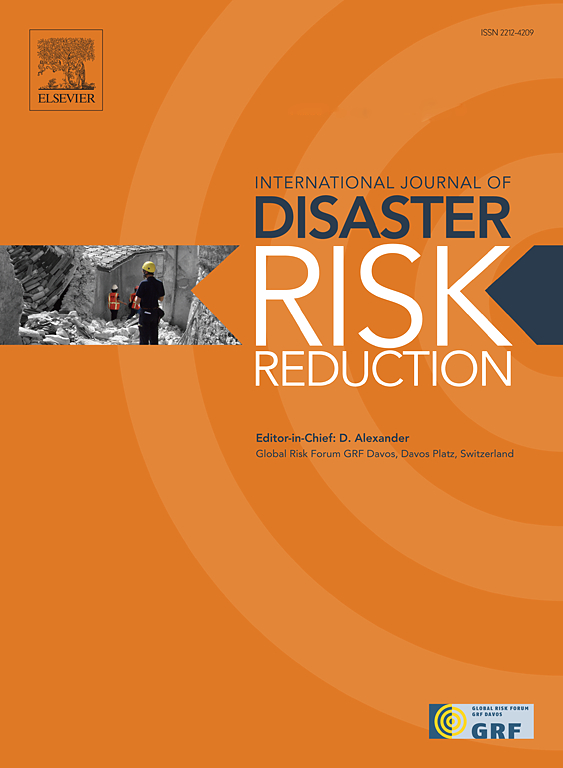Advancing regional analysis of road infrastructure exposure to fault displacement hazard: A New Zealand case study
IF 4.2
1区 地球科学
Q1 GEOSCIENCES, MULTIDISCIPLINARY
International journal of disaster risk reduction
Pub Date : 2025-03-28
DOI:10.1016/j.ijdrr.2025.105440
引用次数: 0
Abstract
We developed an approach to quantify road infrastructure exposure to fault displacement hazard (FDH) that adopts Fault Displacement Hazard Analysis (FDHA) principles and addresses regional-scale challenges for emergency management and network planning. FDH results from ground deformation in surface-rupturing earthquakes and can damage nearby infrastructure. This study assesses New Zealand's road network exposure and vulnerability to FDH by generating displacement fields around faults based on historical earthquake data and physics-based models. Relative hazard is quantified as the product of 1D strain resolved along roads and normalised fault slip-rate, and was mapped at the regional scale. Vulnerability is assessed using geomorphon land class, or the road's position in the landscape, as a proxy for susceptibility to damage and repairability. Four areas emerged as potentially having higher risk: Wellington, the Eastern North Island, the West Coast, and the Upper South Island. We reviewed the local factors that influenced these measurements of hazard, exposure, and vulnerability. The Wellington Region is particularly vulnerable where roads intersect the Hutt Valley and Wairarapa Faults, and sections of State Highway 6 along the Alpine Fault in the West Coast are at heightened risk. This analysis underscores the need for regional approaches to fault displacement hazard and for targeted mitigation, such as fault avoidance, engineering solutions, and planning for rapid post-event repair. Our findings provide insights into horizontal infrastructure resilience planning for transport and other critical systems in seismically active areas.
道路基础设施断层位移危害的区域分析:以新西兰为例
我们开发了一种量化道路基础设施断层位移危害(FDH)的方法,该方法采用断层位移危害分析(FDHA)原则,并解决了应急管理和网络规划的区域尺度挑战。在地表破裂地震中产生的地面变形会破坏附近的基础设施。本研究基于历史地震数据和基于物理的模型,通过在断层周围产生位移场,评估了新西兰道路网络的暴露程度和对外来佣的脆弱性。相对危险度被量化为沿道路分解的一维应变与归一化断层滑动率的乘积,并在区域尺度上进行映射。易损性的评估使用地貌土地类别,或道路在景观中的位置,作为易损性和可修复性的代表。有四个地区出现了潜在的高风险:惠灵顿、北岛东部、西海岸和上南岛。我们回顾了影响这些危害、暴露和脆弱性测量的当地因素。惠灵顿地区在赫特谷和怀拉拉帕断裂带相交的道路上尤其脆弱,而沿着西海岸阿尔卑斯断裂带的6号国道路段的风险更高。这一分析强调了对断层位移危害采取区域性方法和有针对性的缓解措施的必要性,例如断层避免、工程解决方案和事件后快速修复规划。我们的研究结果为地震活跃地区的交通和其他关键系统的横向基础设施弹性规划提供了见解。
本文章由计算机程序翻译,如有差异,请以英文原文为准。
求助全文
约1分钟内获得全文
求助全文
来源期刊

International journal of disaster risk reduction
GEOSCIENCES, MULTIDISCIPLINARYMETEOROLOGY-METEOROLOGY & ATMOSPHERIC SCIENCES
CiteScore
8.70
自引率
18.00%
发文量
688
审稿时长
79 days
期刊介绍:
The International Journal of Disaster Risk Reduction (IJDRR) is the journal for researchers, policymakers and practitioners across diverse disciplines: earth sciences and their implications; environmental sciences; engineering; urban studies; geography; and the social sciences. IJDRR publishes fundamental and applied research, critical reviews, policy papers and case studies with a particular focus on multi-disciplinary research that aims to reduce the impact of natural, technological, social and intentional disasters. IJDRR stimulates exchange of ideas and knowledge transfer on disaster research, mitigation, adaptation, prevention and risk reduction at all geographical scales: local, national and international.
Key topics:-
-multifaceted disaster and cascading disasters
-the development of disaster risk reduction strategies and techniques
-discussion and development of effective warning and educational systems for risk management at all levels
-disasters associated with climate change
-vulnerability analysis and vulnerability trends
-emerging risks
-resilience against disasters.
The journal particularly encourages papers that approach risk from a multi-disciplinary perspective.
 求助内容:
求助内容: 应助结果提醒方式:
应助结果提醒方式:


